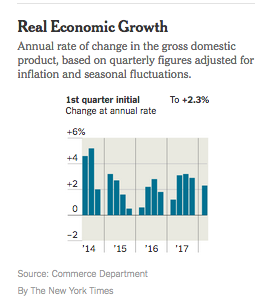. . .
Still, the economy ended up puttering along just a bit above the average yearly growth rate that it had registered since the recession ended nearly nine years ago.
While the pace is equal to the performance for all of last year, it is below the 2.9 percent annualized rate recorded in the fourth quarter of 2017, and short of Mr. Trump’s goal of at least 3 percent. Most forecasters, however, expect quarterly growth to float around the 3 percent mark for the rest of the year.
“This is not too bad,” said Carl R. Tannenbaum, chief economist of Northern Trust in Chicago. “The 2.3 percent figure is moderately encouraging.” Economists had expected economic growth to ease in the quarter.
“The rest of 2018 seems well assured given the substantial support that is going to come from government fiscal policy,” Mr. Tannenbaum said, referring to the $1.5 trillion cost of the tax cuts.
He noted, however, that “longer term, the immediate benefits of tax reform will fade, and what we’ll be left with is the bill.”
Economists on Wall Street and in Washington have repeatedly warned that the economy’s upward streak is unlikely to extend beyond the next year or two. The nation’s debt has topped $21 trillion and is growing, a level many view as unsustainable. And if the Federal Reserve follows through on its plan to raise interest rates, the cost of paying off that debt will grow larger.
In the longer run, the Fed expects real annual growth in the United States to fall to 1.8 percent. The Congressional Budget Office’s 10-year outlook comes to the same disappointing conclusion.
Read full article




